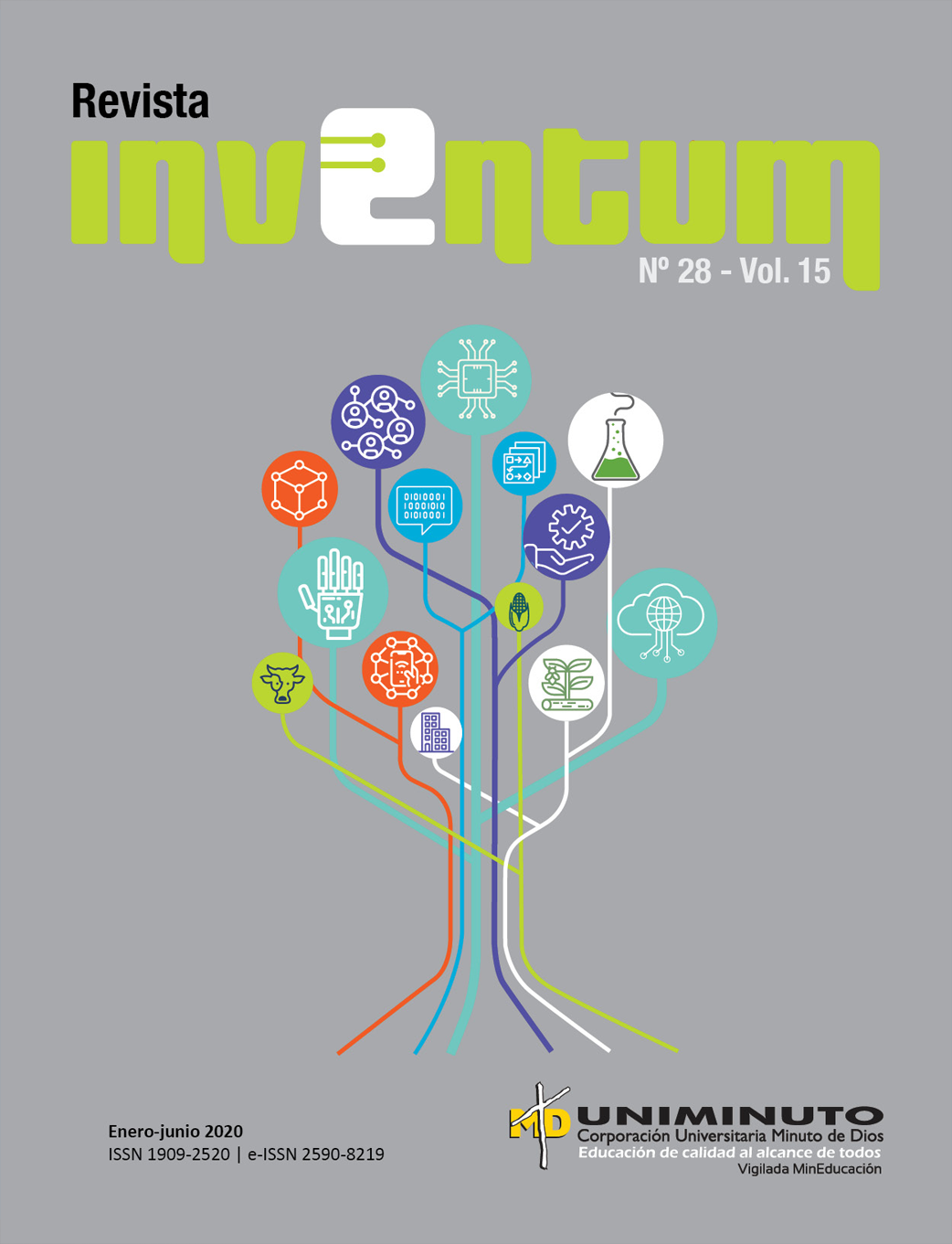Simulación hidrológica para sistemas de drenaje sostenible aplicada en jardines verticales en el humedal La Vaca, Bogotá D.C.
Barra lateral del artículo
Cómo citar
Detalles del artículo
Se solicita a los autores que diligencien el documento de cesión de derechos de autor sobre el artículo, para que sea posible su edición, publicación y distribución en cualquier medio y modalidad: medios electrónicos, CD ROM, impresos o cualquier otra forma, con fines exclusivamente científicos, educativos y culturales
- La obra pertenece a UNIMINUTO.
- Dada la naturaleza de UNIMINUTO como Institución de Educación Superior, con un modelo universitario innovador para ofrecer Educación de alta calidad, de fácil acceso, integral y flexible; para formar profesionales altamente competentes, éticamente responsables y líderes de procesos de transformación social, EL CEDENTE ha decidido ceder los derechos patrimoniales de su OBRA, que adelante se detalla para que sea explotado por ésta
- El querer de EL CEDENTE es ceder a título gratuito los derechos patrimoniales de la OBRA a UNIMINUTO con fines académicos.
Contenido principal del artículo
Resumen
Los Sistemas Urbanos de Drenaje Sostenible (SUDS) en la zona de influencia del humedal La Vaca son una alternativa para promover el uso eficiente del recurso hídrico. Para su simulación se proponen tres componentes principales: evaluación de las potenciales áreas de captación de agua lluvia, optimización de las condiciones de operación hidráulica para un jardín vertical en Corabastos de acuerdo a la hidrología y por último la simulación del sistema hidráulico propuesto en el software Pipe Flow Expert. Los resultados de la simulación sugieren que implementar los SUDS sobre las cubiertas de Corabastos son técnicas factibles dado que no existe ningún periodo de completa sequia durante el año en la localidad de Kennedy; esto permitirá obtener cerca de 1’537.000 litros de agua lluvia anual que podría ser aprovechada de marzo a noviembre sin déficit, cubriría las necesidades de jardines verticales en la zona y añadiría disponibilidad para otros usos. Finalmente, se concluye que este tipo de sistemas permiten mitigar las afectaciones a la infraestructura inundable con enormes beneficios sociales, paisajísticos y ecológicos.
Referencias
Global Environmental Change, vol. 21, nº 2, pp. 628-646, 2011.
[2] P. Gourbesville, “Urban flooding and Resilience: concepts and needs,” en Asamblea General de EGU, Viena, Austria, 2012, p. 14282.
[3] V. Pappalardo y D. La Rosa, “Policies for Sustainable Drainage Systems in urban contexts within performance-based planning approaches,”Sustainable Cities and Society, 2019.
[4] A. Massoudieh, M. Maghrebi, B. Kamrani, C. Nietch , M. Tryby, S. Aflaki y S. Panguluri, “A flexible modeling framework for hydraulic and water quality performance assessment of stormwater green infrastructure,” Environmental
Modelling & Software, vol. 92, pp. 57-53, 2017.
[5] L. Ahiablame, B. Engel y I. Chaubey, “Representation and evaluation of low impact development practices with L-THIA-LID: An example for site planning,” Reinar. Pollut, vol. 1, nº 2, pp. 1-13, 2012.
[6] C. Zamudio, “Gobernabilidad sobre el recurso hídrico en Colombia: entre avances y retos,” Revista Gestión y Ambiente, vol. 15, nº 3, pp. 99-112, diciembre 2012.
[7] Y. Carvajal, “Inundaciones en Colombia. ¿Estamos preparados para enfrentar la variabilidad y el cambio climático?,” Revista Nacional de Investigación Memorias, vol. 9, nº 16, pp. 105-119, 2011.
[8] J. Ballén, M. Galarza y R. Ortiz, “Sistemas de Aprovechamiento de Agua Lluvia,” en Seminário Iberoamericano sobre Sistemas de Abastecimento Urbano de Água João Pessoa (Brasil), 2006.
[9] C. Rojas, B. De Meulder y K. Shannon, “Water urbanism in Bogota. Exploring the potentials of an interplay between settlement patterns
and water management,” Habitat International, nº 48, pp. 177-187, 2015.
[10] S. Perales y I. Doménech, “Los sistemas urbanos de drenaje sostenible: una alternativa a la gestión del agua de lluvia,” 2008.
[11] S. Perales y I. Doménech, “Los sistemas urbanos de drenaje sostenible una alternativa a la gestión del agua lluvia,” Valenica, 2008.
[12] A. Vásquez, “Infraestructura verde, servicios ecosistémicos y sus aportes para enfrentar el cambio climático en ciudades: el caso del corredor
ribereño del río Mapocho en Santiago de Chile,” Revista de Geografía Norte Grande, nº 63, pp. 63-86, 2016.
[13] Secretaría Distrital de Ambiente, Sistemas urbanos de drenaje sostenible, Bogotá, 2011.
[14] D. Barragán y A. Sierra, Las inundaciones en Kennedy (Barrio Tierra Buena) afrontadas desde el diseño de información, Proyecto, Facultad de Arquitectura y Artes, Diseño Gráfico, Universidad Piloto de Colombia, Bogotá, 2013.
[15] Alcaldia Mayor de Bogotá. (2012), Plan Ambiental Local de Kennedy. [En línea]. Disponible en: http://www.ambientebogota.gov.co/documents/10157/2883162/PAL+
Kennedy+2013-2016.pdf.
[16] DANE, “Población 2007,” Bogotá, 2007.
[17] EEAB, “Plan de manejo ambiental del humedal la Vaca,” Bogotá, 2009.
[18] G. González, El impacto de la dinámica urbana sobre los humedales de Bogotá (Colombia). Análisis, modelización y propuestas en el marco del crecimiento verde, Tesus, Universidad de Zaragoza, España, 2018.
[19] T. Van der Hammen, Plan Ambiental de la cuenca alta del río Bogotá: análisis y orientación para el ordenamiento territorial. CAR, Bogotá, Bogotá: CAR, 1998.
[20] G.A. Forero Buitrago, “Dimensionamiento de canales y embalses para conducir y almacenar agua lluvia para abastecer la población de Altos de Cazucá (Soacha-Colombia) utilizando DEM,” Revista de Tecnología, Vol. 16,
n° 1, pp. 113-128, 2018.
[21] Idiger, Hemeroteca de emergencias de Bogotá, Bogotá, 2019.
[22] Idiger, (2018), “Caracterización general de escenario de riesgo de inundación por desbordamiento,” 27 noviembre. [En línea]. Disponible en: http://www.idiger.gov.co/rinundacion.
[23] CYPE Ingenieros S, A., “Generador de precios Colombia,” 2019. [En línea]. Disponible en: http://www.colombia.generadordeprecios.info/obra_nueva/Cubiertas/Planas/No_transitables__no_ventiladas/QAD050_Cubierta_verde__sistema_Urbanscape_.html
[24] Secretaría Distrital de Ambiente, (2018) “Red de Monitoreo de Calidad del Aire de Bogotá,” [En línea]. Disponible en: http://201.245.192.252:81/.
Artículos más leídos del mismo autor/a
- Mariana Alejandra Rodriguez, María Fernanda López Romero, Luisa María Tejada Henríquez, Gonzalo Alberto Forero Buitrago, Modelo de aprendizaje automático como herramienta para la toma de decisiones en la cuenca del río Ariporo , INVENTUM: Vol. 16 Núm. 31 (2021): JULIO-DICIEMBRE





